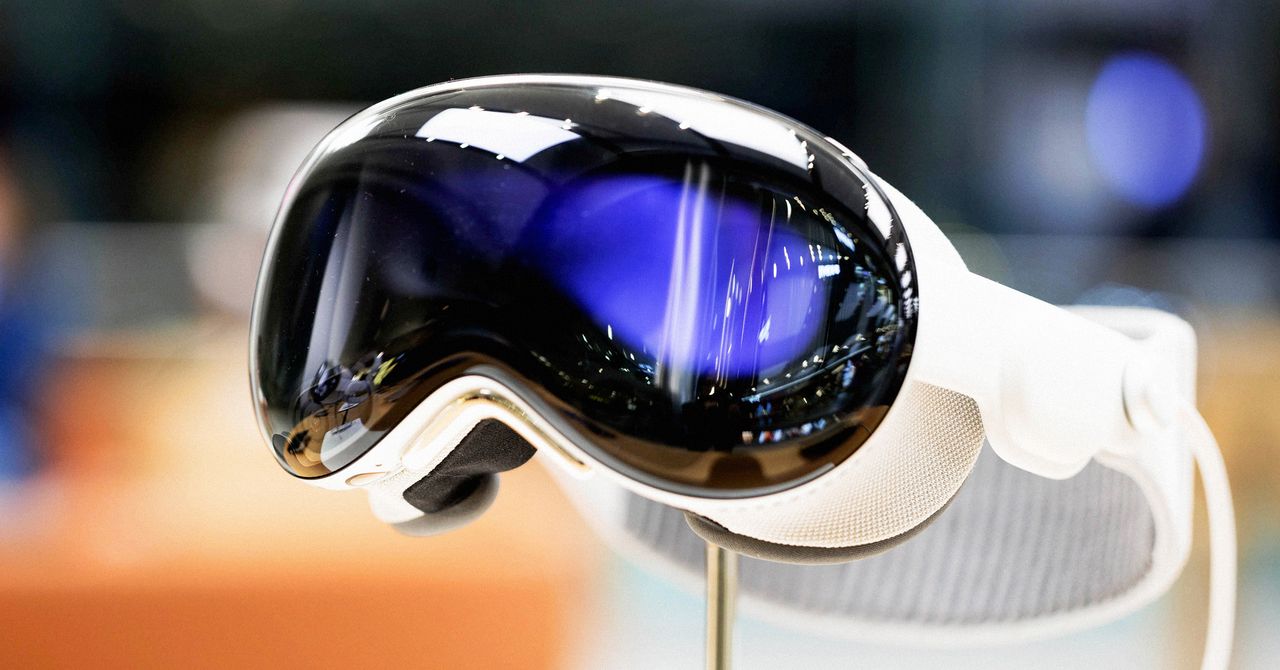Tech
This Startup Wants to Put Its Brain-Computer Interface in the Apple Vision Pro

Now, Cognixion is bringing its AI communication app to the Vision Pro, which Forsland says has more functionality than the purpose-built Axon-R. “The Vision Pro gives you all of your apps, the app store, everything you want to do,” he says.
Apple opened the door to BCI integration in May, when it announced a new protocol to allow users with severe mobility disabilities to control the iPhone, iPad, and Vision Pro without physical movement. Another BCI company, Synchron, whose implant is inserted into a blood vessel adjacent to the brain, has also integrated its system with the Vision Pro. (Apple is not known to be developing its own BCI)
In Cognixion’s trial, the company has swapped out Apple’s headband for its own, which is embedded with six electroencephalographic, or EEG, sensors. These collect information from the brain’s visual and parietal cortex, located at the back of the head. Specifically, Cognixion’s system identifies visual fixation signals, which occur when a person is maintaining their gaze on an object. This allows users to select from a menu of options in the interface using mental attention alone. A neural computing pack worn at the hip processes brain data outside of the Vision Pro.
“The philosophy of our approach is around reducing the amount of burden that is being generated by the person’s communication needs,” says Chris Ullrich, Cognixion’s chief technology officer.
Current communication tools can help but aren’t ideal. For instance, low-tech handheld letterboards allow patients to look at certain letters, words, or pictures so that a caregiver can guess their meaning, but they’re time-consuming to use. And eye tracking technology is still expensive and not always reliable.
“We actually build an AI for each individual participant that is customized with their history of speaking, their style of their humor, anything they’ve written, anything they’ve said, that we can gather. We crunch all that down into something that is a user proxy,” Ullrich says.
Tech
Social Security Data Is Openly Being Shared With DHS to Target Immigrants

Last week, the Social Security Administration (SSA) quietly updated a public notice to reveal that the agency would be sharing “citizenship and immigration information” with the Department of Homeland Security (DHS). This data sharing was already happening: WIRED reported in April that the Trump administration had already started pooling sensitive data from across the government for the purpose of immigration enforcement.
This public notice issued by SSA makes that official, months after the fact. The notice is known as a system of record notice (SORN), a document that outlines how an agency will share the data it has, with whom, and for what purpose. This notice is required under the Privacy Act of 1974. Normally, SORNs are issued before any data is shared between agencies, giving the public and government officials sufficient time to offer comment. But WIRED found that the so-called Department of Government Efficiency (DOGE) was pulling in data from across DHS, SSA, the Internal Revenue Service (IRS), and state voter data, among other sources, based largely on the US Citizenship and Immigration Service’s (USCIS) Systematic Alien Verification for Entitlements (SAVE) database.
“There are laws that require the government to inform the public about their use of various kinds of databases and other surveillance technologies,” says Adam Schwartz, privacy litigation director at the Electronic Frontier Foundation, a nonprofit focused on digital privacy and free speech. “If the government starts using the database and does not put out the appropriate disclosure and then later does put out that appropriate disclosure, they still have violated the law.”
The Trump administration has gone to drastic lengths to remake the government in its image. A core component of this has been an effort to vacuum up large swathes of data from across federal agencies, many of which were never meant to be comingled. This has frequently happened regardless of the laws, norms, or procedures that normally govern the access and sharing of sensitive data. The SORN from SSA is just the latest confirmation of exactly how much data is being shared in ways experts tell WIRED is “unprecedented.”
Much of this data sharing begins with misinformation about the data at hand. In the early days of the Trump administration, Elon Musk seized on a misunderstanding of SSA’s data to spread the claim that 150-year-old people were receiving benefits. They weren’t, but DOGE capitalized on the idea that the SSA’s systems were inefficient and fraudulent to burrow into the agency’s data and technology systems. In April, reporting from The New York Times found that in an effort to force immigrants to self-deport, the administration was adding them to the SSA’s database of dead people, effectively meaning that their Social Security numbers could not be used to get jobs or access government services. As part of the effort to combine disparate data across the government to verify citizenship and surveil immigrants, DHS recently published a different but related SORN that effectively transforms SAVE into a voter verification system, which experts also warned could be bypassing the requirements of the Privacy Act.
Leland Dudek, who served as acting commissioner for the Social Security Administration between February and May 2025, led the agency when members of DOGE first appeared. Dudek says he was initially supportive of DOGE and acted as a bridge between SSA staff and members of the DOGE team before becoming disillusioned.
Tech
This 3-in-1 Le Wand Vibrator Is Out of This World

When you flip the Lick around, things look more complicated—especially if you’re new to suction play—but if you take your time to understand these features, you’ll be a happy camper. On this end, you have a suction cup and a tongue-shaped clitoral stimulator. Remove the cup—just a quick twist and it’s off—you can easily access the flicking tongue. The tongue has three speeds that, with a bit of water-based lube, are meant to mimic the sensation of oral sex.
It didn’t feel much like oral sex to me, which probably says more about my partners than the Lick, but it felt great against my clitoris. So much so that this was my favorite function of the Lick. However, I want to stress the importance of lube. To truly experience the incredible sensations, you want it to glide seamlessly over your clitoris. Because your clit doesn’t naturally lubricate, the best way to make that happen is with your favorite water-based lube.
Finally, we get to the suction feature. While not as intense as sex toys that market themselves as bona fide pussy pumps, the suction on the Lick is pretty strong. Before I used it on my vulva, I used the pump of my hand to get an idea of what I was up against, and there was some major sucking happening. If you’re unsure why this might be an asset when dealing with pleasure, it comes down to sensitivity.
With the suction cup on your vulva, each time you press the corresponding button, it tightens its grip, essentially demanding that more blood come into the vulva. When this happens, sensitivity in the area is heightened, which, for some, can lead to stronger and longer orgasms. While not a sensation that everyone may be into, it is one that, if you haven’t tried it, is worth giving it a whirl at least once—if only to prove to yourself it’s not (or absolutely is) for you.
Some Initial Finagling
Courtesy of Le Wand
As much as the Lick’s features deliver on the pleasure front, the four control buttons are a bit difficult to navigate at first. When you hold the Lick in your hand with the suction cup at the top, the buttons descend in order down the shaft. The on/off button is second-to-last—most sex toys give this button its own spot, or at the top or bottom of the layout of buttons. That way, you won’t push it accidentally in the heat of the moment and kill the vibe. Sadly, that exact thing happened to me. The buttons just didn’t make sense in my brain.
Battery life is very much dependent on how you use the Lick. It takes about two hours to fully charge, and with that, you can get anywhere from 80 to 180 minutes of run time. I didn’t exhaust the vibrator by trying to get 180 minutes out of it, but that’s a broad spectrum of time that should be taken into consideration.
Ultimately, the Le Wand Lick 3-in-1 does exactly what it promises: gets you off. It’s waterproof, has a unique look, and its trio of options keeps things interesting. I’ve only used the Lick solo, but I can definitely see the pussy pump feature being a fun little addition to partnered play.
Tech
Squarespace Promo Codes: 10% Off November 2025

Squarespace helps small businesses and regular Joe Schmoes to get software help to build their own websites (for both personal and business), even including the commerce side of things with point of sale, inventory, and customer data features (both online or in person). In the age where literally everything is digitized and accessed through the World Wide Web, having an online presence is the most important thing you can do for your business or brand’s growth. Creating a website can be difficult, with the HTMLs and coding and what not—that’s where Squarespace comes in. And we’ve found some of the best Squarespace discounts to help you save while growing your business.
Get 10% Off With This Exclusive Squarespace Promo Code
One of the best things about Squarespace is the versatility of it—compared to other website builders, it’s hard to beat in terms of the large number of layout options, user-friendly interface, and the various features available. Some of those features include built-in ecommerce capabilities (for those hoping to sell their work), promotion marketing tools, and booking and appointment handling. WIRED even named Squarespace one of the best websites to show off your portfolio of work. Right now, first-time users can get 10% off any website or domain plan, plus a 2 week free trial period. All you need to do is click the coupon above and enter the Squarespace promo code at checkout to get the deal.
Use Squarespace Promo Code to Save on a New Website or Domain
Once you find the plan you want—the Squarespace coupon is valid on any plan—enter the Squarespace discount code. Enter the Squarespace promo code WIRED10 into the box at checkout to see the savings roll in.
Save up to 36% on Squarespace Plans
Squarespace continues to reign at the top of our list of the best website builders, with features and customizable templates that help any skill level design like a pro. But don’t just take our word, users can start with a free 14-day trial and then make a decision on which plan best suits their personal or business’ needs. Squarespace frequently releases discount codes for 20% off new websites, but forget needing one–the easiest way to save is through an annual plan, which on average saves around 28-36% by locking in an annual price rather than a pay-as-you-go model with the monthly plan. You’ll need your business to have a website for longevity, so I’d recommend buying long term and saving big.
Prices per plan range, with the basic at $16 per month for 36% off with the yearly plan, Core at $23 per month for 36% off, and Plus at $39 per month for 30% off. The Advanced plan is $99 per month at 28% off—this includes features from cheaper plans, and also has the lowest payment processing fees, improved CSS, and JavaScript customization.
Students Get a 50% Off Squarespace Discount Code
Like Millennials and Gen Z-ers, Squarespace knows just how important our digital footprint is in this day and age. That’s why Squarespace is offering a student discount, where students can get 50% off annual plans to help launch their burgeoning business. All you need to do to get the Squarespace coupon code is verify your student status with Student Beans. Once you’ve verified using the free service, just input the offer code during checkout. Note: authorized students can obtain only one code every 12 months, whether the offer code is redeemed or not.
20% Off for Squarespace Circle Customers
Squarespace Circle perks is how people can get rewarded for using the platform. To join, users must have three Squarespace websites already. There are tons of perks for any small biz owner using Squarespace Circle, including: commission for bringing new folks to Squarespace, a 20% discount on new website subscriptions when you reach Platinum status, 20% off new annual email campaigns and scheduling subscriptions, a six-month free trial, priority customer support, educational resources and more. Although the benefits are tiered based on the number of websites you publish, the free option of Circle offers a 10% discount on annual plans, 3 month free trials, and early access to news on product launches. Check out the links above to see if Squarespace Circle would be a good fit for you (or your business).
Check Out the New Squarespace AI Website Builder
AI is everywhere, and here at WIRED, we know it all too well. Squarespace is jumping on the AI bandwagon, with its new Blueprint AI service, which helps you smartly build your website. It’s free to use, although you need a paid Squarespace account to publish any website you create with Blueprint AI. If that’s not your jam and you prefer to go a little more old school, you can browse pre-built website templates, including specific designs optimized for various business focuses and needs.
Squarespace is one of the most versatile and user-friendly website builders out there, and with WIRED’s Squarespace discount code, you can save 10% on any plan.
Get 20% Off Squarespace Acuity Scheduling (Or Try it for Free)
Squarespace Acuity Scheduling is an online scheduling solution for your business that completes annoying (but necessary) administrative tasks like calendar syncing, automated email and text message reminders, payment processor integrations, and more.
Plus, you don’t even need a Squarespace website to use Acuity. It includes a separate scheduling page clients can visit to book appointments, and you can embed your Acuity scheduler in almost any website. Then, if you decide to add a website from Squarespace, it’s super easy to use Squarespace’s tools and pre-designed templates. They make it easy, with a free trial option that requires no website or credit card. If you decide on a plan, you’ll save 20% annually on Starter and Standard, and19% off Premium.
-

 Tech1 week ago
Tech1 week agoFrom waste to asset: Turning ethanol production CO₂ into jet fuel
-

 Tech3 days ago
Tech3 days agoNew carbon capture method uses water and pressure to remove CO₂ from emissions at half current costs
-

 Politics4 days ago
Politics4 days agoBritish-Pakistani honoured for transforming UK halal meat industry
-

 Sports3 days ago
Sports3 days agoTexas A&M officer scolds South Carolina wide receiver after touchdown; department speaks out
-

 Tech1 week ago
Tech1 week agoSecurity flaws in portable genetic sequencers risk leaking private DNA data
-

 Fashion5 days ago
Fashion5 days agoAdidas & Patrick Mahomes expand NIL programme with Texas Tech athletes
-

 Business4 days ago
Business4 days agoWhat’s behind Rachel Reeves’s hokey cokey on income tax rises?
-

 Politics5 days ago
Politics5 days agoInternet freedom declines in US, Germany amid growing online restrictions

















